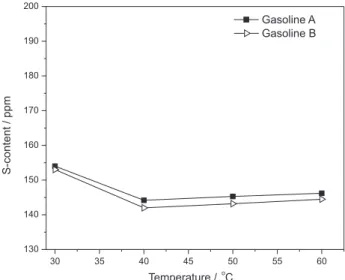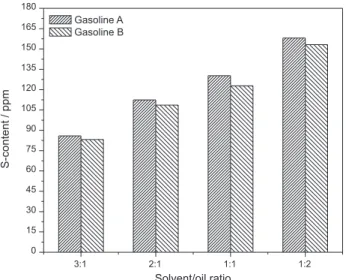Article
Printed in Brazil - ©2016 Sociedade Brasileira de Química0103 - 5053 $6.00+0.00
*e-mail: gryu@mail.buct.edu.cn, chenxc@mail.buct.edu.cn
Oxidative Desulfurization of Gasoline by Ionic Liquids Coupled with Extraction by
Organic Solvents
Rashid Abro,a Shurong Gao,a Xiaochun Chen,*,a Guangren Yu,*,a Ahmed A. Abdeltawabb
and Salem S. Al-Deyabb
aBeijing Key Laboratory of Membrane Science and Technology & College of Chemical Engineering,
Beijing University of Chemical Technology, 100029 Beijing, P. R. China
bDepartment of Chemistry, College of Science, King Saud University, 11451 Riyadh,
Saudi Arabia
In this work, desulfurization of real fluidized catalytic cracking (FCC) gasoline was investigated in dual steps; first in oxidative desulfurization (ODS) using imidazolium and pyrrolidonium based Brønsted acidic ionic liquids (ILs) as solvent and catalyst and hydrogen peroxide as oxidant. In second step, extractive desulfurization took place using organic solvents of furfural, furfural alcohol and ethylene glycol. Variety of factors such as temperature, time, mass ratio of oil/ILs and regeneration and recycling of ILs, multiple-step desulfurization of ILs and organic solvents and solvent/oil ratio were also investigated. The S-content was significantly decreased to ca. 18 ppm from initial S-content of 260 ppm with a total S-removal of ca. 95% in one-step ODS using pyrrolidonium based ILs coupled with five-step extraction desulfurization (EDS) using furfural alcohol as extractant. This work shows that oxidative desulfurization using ionic liquids coupled with extractive desulfurization using organic solvents is a potential method to produce clean gasoline.
Keywords: gasoline, oxidative desulfurization, extractive desulfurization, ionic liquids, ultra-clean fuel oil
Introduction
The emission of sulfur (S) during combustion from light fuel oils, coupled with increasing automobiles has heightened concern on environmental pollution. The sustained emission of these gases leads to air pollution, acid rain, and global climate change as well as increases health risk from continuous exposure to this smog. Economically, it affects the catalytic converter emission of vehicles resulting in inefficient fuel utilization and poor performance. In 1998, the European Union instituted legislations to monitor the S-limits in fuel oils by setting up mandatory S-content limit to be less than 10 ppm or negligible level.1-3 In March 2014, the United States
Environmental Protection Agency proposed new standards to further reduce the S-content from the current 30 to 10 ppm. In recent years, Japan has also made significant efforts to reduce the S-content from 500 to 50 ppm. Some European countries including Denmark and Germany
have imposed taxes on fuel oil refineries that fail to meet the standard (Figure 1 shows the maximum gasoline S-limits in different regions).4 The goal, of course, is to
realize ultra-low, possibly zero, S-content in gasoline in the not-too-distant future.
2000 2005 2010 2015
0 100 200 300 400
500 USA
Japan EU China (Beijing)
S
-c
o
n
te
n
t
lim
it
a
ti
o
n
/
p
p
m
Year
Hydrodesulfurization (HDS) is the well-established method employed in industry for this regard, where S-compounds are converted into hydrogen sulfide (H2S)
in the presence of catalyst at elevated temperatures and pressures. HDS has some disadvantages such as the need for expensive catalysts, high temperature (300 to 340 °C) and high pressure (20 to 100 atm of H2). More
importantly, aliphatic thiols and sulfides can effectively be removed in HDS while thiophene and its derivatives are not easily removed because of the steric hindrance for catalysis.6 Therefore, some alternative techniques
such as adsorption desulfurization (ADS),7-9 extraction
desulfurization (EDS),10-12 oxidation desulfurization
(ODS),13,14 and biodesulfurization (BDS)15,16 are sought
in order to complement the HDS process. ODS is more competitive and efficient in removing the thiophenic S-compounds under mild conditions with low costs.17-19 The
use of molecular organic solvents such as dimethylsulfoxide (DMSO), dimethylformamide (DMF) and acetonitrile in ODS has been patented; some problems, however, exist in employing these organic solvents such as loss, contamination, regeneration, recycling and safety issues stemming from the volatile nature of organic solvents.20-25
Recently, ionic liquids (ILs) have attracted increasing attention thanks to their desirable physicochemical properties such as negligible volatility, easy alteration of cation/anion structure for specific applications, high thermochemical stability and remarkable ability in dissolving organic/ inorganic compounds. With wide-ranging applications in separation technology, nanotechnology, catalysis, electrochemistry, etc., ILs are being acclaimed as “green”
and “designer” solvents.26-28 Several ILs have been studied as
solvent in EDS for S-removal from fuel oils such as [1-butyl-3-methylimidazolium (Bmim)]PF6,29,30 [Bmim]BF4,29,30
[1-methyl-3-octylimidazolium (Omim)]BF4,31,32
[Bmim][CF3SO3],33 [Omim][OcSO4],33 [Bmim]AlCl4,34
[Bmim]Cl/Cu2Cl3,35 [1-ethyl-3-methylimidazolium (Emim)]
dicyanamide (DCA)36 and [Bmim]DCA.37 Compared
with EDS alone using ILs, some researchers observed that ODS is much more efficient and S-removal can be increased up to 90% from 10-40% in EDS, such as [butyl-6-methylquinolinium (Bmimquin)]DCA in ODS process removed 99.9% of S-contents at mild conditions from model diesel fuel.38 In a typical ODS, S-compounds in
gasoline fuel are extracted into the IL phase first, then oxidized by some oxidant, and the oxidized product is more polar and easily removable. The oxidant is usually the cheap and environmentally benign hydrogen peroxide (H2O2) solution, while the catalysts are usually acetic acid,39
vanadium pentoxide,40 decatungstates,41 peroxotungsten, or
peroxomolybdenum complexes.42
Due to regeneration and contamination problems of acid catalyst, recently, some acidic ILs have been used in ODS, where those ILs act as both catalyst and solvent, and no other acid catalyst is added, as shown in Figure 2. In the literature, most emphases are placed on model fuel oils, which are configured by S-compounds (thiophene, dibenzothiphene, and their derivatives) and a certain amount of aliphatic (hexane, heptane, n-dodecane, etc.) and aromatic (usually toluene) compounds while the investigations on real feedstock are rather scarce, as listed in Table 1. The results for model oils may not present a conclusive argument.
S
S O O S
H2O2
Oil phase
IL phase
DBT-sulfone DBT
IL
H2O2
Figure 2. Oxidation of S-component using H2O2 and ILs. S
S O O S
H2O2
Oil phase
IL phase
DBT-sulfone DBT
IL
In this work, we synthesized four Brønsted acidic ILs namely [Hnmp]HSO4, [Hnmp]H2PO4, [Bmim]H2PO4
and [Bmim]HSO4 and investigated the desulfurization of
real fluidized catalytic cracking (FCC) gasoline in two steps: the first in ODS using above ILs as extractant and catalyst and H2O2 as oxidant; the second in EDS using
different organic solvents of furfural, furfural alcohol and ethylene glycol (the ILs, also organic solvents, used in this work are illustrated in Figure 3), involving a variety of factors such as temperature, time, and regeneration of ILs, multiple-step desulfurization and solvent/oil mass ratio. These ILs act as both catalyst and solvent, also can easily be prepared with cheaper starting materials and can be regenerated easily, whereas all selected organic solvents are also reasonable candidates for EDS due to their physical characteristics, i.e., immiscible with gasoline (gasoline is miscible with most organic solvents), low volatility, less operational problems, good thermal stability and high boiling points (160-200 oC). This
work shows that ODS using ILs coupled with EDS using organic solvents is a potential method to produce clean gasoline.
Experimental
Chemicals and material
The chemicals are: N-methylimidazole (≥ 99.0%) (Shanghai SenHao Fine Chemical); ethyl acetate (≥ 99.0%), H2O2 aqueous solution (30 wt.%), H2SO4 (98%), H2PO4
(85%), N-methylpyrrolidone (NMP), furfural alcohol, furfural and ethylene glycol (Beijing Chemical Plant).
N-Methylimidazole is further purified by distillation, and the other chemicals were used as received without further purification. Real FFC gasoline fuel with a total S-content of 260 ppm was supplied by SINOPEC Beijing Yanshan Petrochemical Co., Ltd (properties of gasoline are given in Table 2).
Table 1. ODS of real fuels by ILs
ODS using IL system Oil S0 /
ppm
Desulfurization efficiency / %
Reaction conditions
Reference Temperature /
K time / h IL/oil mass ratio
ODS steps
O/S molar ratio
[Bmim]BF4 + H2O2 light oil 3640 54.72 333 10 n/a 6 n/a 43
[Bmim]PF6 + H2O2 light oil 1300 83.83 333 10 n/a 6 n/a 43
C5H9NO·SnCl2 + H2O2 diesel 492 87.3 333 4 1 6 16 44
[Bmim]Cl/3ZnCl2-H2O2 diesel 460 63.5 313 3 1/2 6 40 45
[Hmim]BF4 + H2O2 diesel 1000 73.0 363 6 5:3.2 (v/v) – 40 46
[Hnmp]H2PO4 + H2O2 diesel 795 64.3 333 4 1 6 16 47
[Bmim]HSO4 + H2O2 diesel 97 85.5 RT 2 1 – 5 48
[Bmim]Cl/2ZnCl2 + H2O2 diesel 5380 87.7 363 1 1 or 1/2 7 50 49
[Bmim]Cl/2ZnCl2 + H2O2 diesel 64 49.5 363 1 1 and 1/2 5 50 49
[OmPy]FeCl4 + H2O2 gasoline 468 45 298 0.5 1/5 or 1/3 – 6 50
[BPy]BF4 + H2O2 gasoline 780 56.3 328.15 0.5 IL/oil/H2O2 = 1:1:0.4 (v/v/v) – – 51
[Hnmp]Cl/ZnCl2-H2O2 diesel 225 83.9 333 3 1 6 50 52
[Hnmp]Cl/ZnCl2-H2O2 diesel 225 97 333 3 1 6 50 52
with one EDS step with furfural at 313 K; 1 h, sol/oil ratio = 1
[Hnmp]HSO4 + H2O2 gasoline 260 57 333 4 1 6 16 this work
[Hnmp]HSO4 + H2O2 +
furfural alcohol
gasoline 260 94 333 4 1 1 16 this work
with 5 EDS steps with furfural alcohol at 313 K, 1 h, sol/oil ratio = 1
[Hnmp]H2PO4 + H2O2 gasoline 260 62 333 4 1 6 16 this work
[Hnmp]H2PO4 + H2O2 +
furfural alcohol
gasoline 260 93 333 4 1 1 16 this work
with 5 EDS steps with furfural alcohol at 313 K, 1 h, sol/oil ratio = 1
[Bmim]H2PO4 + H2O2 gasoline 260 20.9 333 4 1 6 16 this work
[Bmim]HSO4 + H2O2 gasoline 260 18.2 333 4 1 6 16 this work
ODS: oxidative desulfurization; IL: ionic liquid; S0: initial S-content; Bmim: 1-butyl-3-methylimidazolium; n/a: not applicable; Hmim:
Synthesis of ILs
[Hnmp]HSO4, [Hnmp]H2PO4, [Bmim]HSO4 and
[Bmim]H2PO4 were synthesized according to the
procedures as mentioned in the literature.53-55
Preparation of [Hnmp]HSO4 and [Hnmp]H2PO4
NMP (60 mL) was placed in a three-necked flask, which was provided with a stirrer at room temperature. Then, stoichiometric amount of H2SO4 (98%) or H2PO4 (85%) was
added to the three-necked flask slowly over a period of 1 h while stirring at room temperature. The reaction mixture was stirred and heated to 80 oC for 2 h. The residual reactant
and water were removed by a rotary evaporator. The IL was dried in vacuum to give the product as a colorless liquid.
The nature of cation and anion in [Hnmp]HSO4 and
[Hnmp]H2PO4 was determined with Fourier transform
infrared (FTIR) spectroscopy and nuclear magnetic resonance (NMR) spectra.
[Hnmp]HSO4
IR (KBr) ν
max / cm-1 3406.2, 2979.5, 2895.7, 2521.7,
1825.8, 1698.4, 1495.5, 1460.9, 1409.8, 1313.0, 1230.4, 1167.7, 1021.7, 982.6, 881.0, 645.5, 578.4, 465, 434.8;
1H NMR (400 MHz, D
2O) d 4.88 (bs, 1H), 3.24-3.20 (t,
2H), 2.54 (s, 3H), 2.17-2.13 (d, 1H).1.77-1.73 (m, 2H).
[Hnmp]H2PO4
IR (KBr) νmax / cm-1 2940.0, 2891.3, 1627.7, 1509.0,
1408.8, 1307.6, 1260.9, 1117.0, 1003.7, 884.1, 747.8, 665.1, 665.1, 617.7, 486.2, 403; 1H NMR (400 MHz, D
2O) d 4.82 (bs, 1H), 3.32-3.28 (t, 2H), 2.45 (s, 3H), 2.08-2.04 (d, 1H), 1.7-1.67 (m, 2H).
Preparation of [Bmim]HSO4 and [Bmim]H2PO4
[Bmim]HSO4 and [Bmim]H2PO4 derived from
imidazole chloride salts were obtained by a drop-wise addition of one equivalent of concentrated H2SO4
(98%) or H2PO4 (85%) to solution of the corresponding
1-butyl-3-methylimidazolium chloride in anhydrous methylene chloride. The reaction proceeded at room temperature for 24 h with vigorous stirring under a stream of dry nitrogen. Then, the mixture was dried in vacuum by a rotary evaporator to remove the HCl and solvent to obtain the viscous clear [Bmim]HSO4 and
[Bmim]H2PO4.
Desulfurization and recycling
IL and desired amount of 30 wt.% H2O2 were introduced
into a 150 mL round-bottom flask. The FCC gasoline fuel was added, then mixture was magnetically stirred for specified time and temperature for ODS process. Then the mixture was allowed to settle for 5 min to obtain phase splitting and the S-content in the upper oil phase was measured. For EDS using organic solvents, desired amount of organic solvent and FCC gasoline fuel were put into 150 mL round-bottom flask. Then mixture was magnetically stirred at a desired time and temperature. The upper oil phase was periodically removed and analyzed for S-content. After each ODS, the bottom IL phase was treated with a rotary evaporator to remove impurities, and the IL was recycled.
S-content analysis
The S-content in real FFC gasoline fuel oil was analyzed by a WK-2D microcoulomb analyzer (Jiangfen
NH HSO
4
O
NH
O C C
H H
3 3
H2PO4
N N
HSO4
N N
H2PO4 C
C H
H
3
3
[Bmim]HSO4
[Bmim]H2PO4
[Hnmp]HSO4
[Hnmp]H2PO4
O O
H
O
OH
OH OH
Furfural Furfural alcohol
Ethylene glycol
Figure 3. Structures of ILs and organic solvents used in this work.
Table 2. Physicochemical properties of gasoline
Property Value
S-content 260 ppm
Viscosity (20 °C) 0.701 mm2 s-1
Boiling point initially 40 °C
Density 0.7-0.8 g cm-3
Color pale brown
Vapor pressure ca. 600 mm Hg
Electroanalysis Co., Ltd.), in which high purity nitrogen gas was used as carrier gas while oxygen gas was used as reaction gas; select vaporization zone temperature: 620 °C; combustion zone temperature: 820 °C; temperature of stable segment: 720 °C.
Results and Discussion
ODS using ILs
The ODS results of FFC gasoline fuel by four Brønsted ILs for one step at 60 oC, time = 4 h, IL/oilmass ratio = 1
and O/S molar ratio = 16 are shown in Figure 4. Efficiency of S-removal from FFC gasoline follows the order [Hnmp]HSO4 > [Hnmp]H2PO4 > [Bmim]HSO4 >
[Bmim]H2PO4 with S-removal efficiencies of 25.3 >
23.8 > 20.9 > 18.2%, respectively. Here, the S-removal efficiency is defined as
(1)
where S0 is the S-content in the gasoline before ODS
and Sf is the S-content after ODS. The acidities of
[Hnmp]HSO4 and [Hnmp]H2PO4 are expected to be
stronger than that of [Bmim]HSO4 and [Bmim]H2PO4,
respectively, because there is acidic proton on [Hnmp]+,
which is favorable when ILs act as acidic catalyst. [Hnmp]HSO4 and [Hnmp]H2PO4 with highest desulfurization
efficiency are chosen to undergo further investigation for the different parameters on S-removal efficiency such as reaction time, temperature, multiple ODS steps, recycling efficiency.
Reaction time
The ODS results using [Hnmp]HSO4 and [Hnmp]H2PO4
at 2, 4, and 6 h are shown in Figure 5. Four hours are enough to reach the equilibrium of desulfurization when the S-removal efficiencies are 25.4 and 23.7% for [Hnmp]HSO4
and [Hnmp]H2PO4, respectively, at 60 °C, IL/oil = 1 and
O/S = 16 after single step, while S-removal are only slightly increased to 25.6 and 24.1%, respectively, after 6 h. Two hours are too short when the S-removal efficiencies are 16.2 and 17.1% for [Hnmp]HSO4 and [Hnmp]H2PO4,
respectively. Thus, 4 h may be considered as a moderate time for better ODS desulfurization result.
Reaction temperature
The effects of temperature on ODS desulfurization performance by [Hnmp]HSO4 and [Hnmp]H2PO4 are
investigated at 30, 45 and 60 oC. The results are shown
in Figure 6. A rise in the reaction temperature from 30 to 60 oC leads to a remarkable increase in the S-removal
efficiency using [Hnmp]HSO4 and [Hnmp]H2PO4 from 12
to 25.3% and 11.6 to 23.7%, respectively, with one step (4 h, IL/oil = 1, O/S = 16). These results can be explained by the strong dependence of the oxidation reaction rate on the reaction temperature. In addition, higher temperature may decrease the viscosity of ILs, enhance effective mixing and inter-phase mass transfer, and H2O2 may be used
effectively after decomposition.50-52 On the other hand, too
high temperatures are not good choice and might lead to auxiliary risk of explosion in the process, although high temperature enhances H2O2 decomposition. Therefore,
reaction at higher temperature should be carefully avoided.
0 5 10 15 20 25
[Bmim]HSO4 [Bmim]H2PO4
S-remova
l
e
ff
ic
ie
n
c
y
/
%
[Hnmp]HSO4 [Hnmp]H2PO4
Figure 4. ODS S-removal efficiency by four Brønsted acidic ILs: [Hnmp]HSO4, [Hnmp]H2PO4, [Bmim]HSO4, and [Bmim]H2PO4 (after
one-step ODS, 60 °C, 4 h, 260 ppm of initial S-content, 16 of molar ratio of O/S, 1:1 of mass ratio of IL/oil).
2 4 6
0 10 20 30 40
S-remova
l
e
fficienc
y
/
%
time / h
[Hnmp]HSO4 [Hnmp]H
2PO4
Figure 5. Influence of time on ODS S-removal efficiency of [Hnmp]H2PO4 and [Hnmp]HSO4 (after one-step ODS, 60 °C, 260 ppm
Thus, a moderate temperature of 60 °C presents the best desulfurization result.
IL regeneration
Regeneration of ILs is a necessary process from environmental and economical point of view. After each ODS run, the ILs phase undergoes rotary evaporation to remove impurities, and then the system is charged again with fresh H2O2 solution for the next ODS cycle. The desulfurization
results by [Hnmp]HSO4 and [Hnmp]H2PO4 after six cycles
are shown in Figure 7. Results indicate that [Hnmp]HSO4 and
[Hnmp]H2PO4 can be regenerated and then recycled more
than six times with no notable decline in efficiency, e.g., the S-removal only drops from 25.2 to 23.7% for [Hnmp]HSO4
and 23.8 to 22.4% for [Hnmp]H2PO4. This small decline
might be ascribed to accumulation of oxidation products.52
Multiple-step ODS
ODS by multiple-step is an effective way to reduce the S-content of heterocyclic compounds in FCC gasoline. The desulfurization results after multiple-step are shown in Figure 8. After first ODS step, S-content from real FCC gasoline decreased from 260 to 194.6 ppm by [Hnmp]HSO4, and to 198 ppm by [Hnmp]H2PO4 with 25.3
and 23.8% desulfurization efficiencies. After six ODS cycles, desulfurization efficiencies of real FFC gasoline fuel by [Hnmp]HSO4 and [Hnmp]H2PO4 increased to 57 and 62%,
respectively. Overall, this performance is not at desired level, when we compare these results with ODS using ILs of model fuels from literature due to complex composition of real FCC gasoline.
EDS using organic solvent after ODS
The EDS results by furfural, ethylene glycol and furfural alcohol for gasolines A and B are shown in Figure 9, where gasoline A is the gasoline after one-step ODS by [Hnmp]HSO4
and gasoline B is that after one-step ODS by [Hnmp]H2PO4.
As shown in Figure 9, these solvents present very different EDS capability. It is observed interestingly that the final S-contents in gasoline can be reduced to < 20 ppm with about 95% S-removal after 5-step EDS by furfural and furfural alcohol; while the EDS capability by ethylene glycol is far from that by furfural and furfural alcohol, e.g., the final S-content in gasoline is larger than 110 ppm with only about 55% S-removal by ethylene glycol. As shown in Table 1, where some ODS results of real gasoline and diesel fuel using ILs are summarized, our results are very competitive. It has to be mentioned that the ODS results
30 45 60
0 5 10 15 20 25 30
[Hnmp]HSO4 [Hnmp]H2PO4
S-remova
l
e
ff
ic
ie
n
c
y
/
%
Temperature /o
C
Figure 6. Influence of temperature for ODS S-removal efficiency of [Hnmp]H2PO4 and [Hnmp]HSO4 (after one-step ODS, 4 h, 260 ppm of
initial S-content, 16 of molar ratio of O/S, 1:1 of mass ratio of IL/oil).
1 2 3 4 5 6
0 5 10 15 20 25 30
S-remova
l
e
ff
ic
ie
n
c
y
/
%
Regeneration cycle
[Hnmp]HSO4
1 2 3 4 5 6
0 5 10 15 20 25 30
S-remova
l
e
ff
ic
ie
n
c
y
/
%
Regeneration cycle
[Hnmp]H2PO4
Figure 7. Influence of IL recycling on S-removal efficiency by [Hnmp]HSO4 and [Hnmp]H2PO4 (after one-step ODS, 60 °C, 4 h, 260 ppm
for gasoline are not as good as diesel fuel, which might be ascribed to the different S-species in gasoline and diesel fuel. Further, Figure 9 shows furfural alcohol has slightly better ODS capacity than furfural, and furfural alcohol can reduce the S-content in gasoline A to 16.1 ppm (93% S-removal) and in gasoline B to 16.8 ppm (94% S-removal). Furfural alcohol was chosen to undergo further investigation for the extraction temperature, extraction time, and solvent/gasoline ratio for gasolines A and B.
Extraction temperature
The results of one-step EDS by furfural alcohol for gasolines A and B at 30, 40, 50 and 60 oC are shown in
Figure 10. The best results are obtained at 40 oC, where the
S-contents are reduced to 144 and 142 ppm for gasolines A and B, respectively (1 h, mass ratio of solvent/oil 1:1). The S-removals at 30 oC are slightly lower than that at 40 oC,
which might be ascribed to the slow mass transfer at lower
0 1 2 3 4 5 6
0 50 100 150 200 250
S
-c
o
n
te
n
t
/
p
p
m
Step
[Hnmp]HSO
4
0 1 2 3 4 5 6
0 50 100 150 200 250
S
-c
o
n
te
n
t
/
p
p
m
Step
[Hnmp]H2PO4
Figure 8. Influence of multiple steps of ODS desulfurization of [Hnmp]HSO4 and [Hnmp]H2PO4 (60 °C, 4 h, 260 ppm of initial S-content,
16 of molar ratio of O/S, 1:1 of mass ratio of IL/oil).
1 2 3 4 5
0 20 40 60 80 100 120 140 160
S
-c
o
n
te
n
t
/
p
p
m
Extraction step Furfural Furfural alcohol Ethylene glycol (a)
1 2 3 4 5
0 20 40 60 80 100 120 140 160
S
-c
o
n
te
n
t
/
p
p
m
Extraction step Furfural Furfural alcohol Ethylene glycol (b)
Figure 9. EDS S-removal efficiency of (a) gasoline A and (b) gasoline B by organic solvents (40 °C, 1 h, 1:1 of mass ratio of solvent/oil).
30 35 40 45 50 55 60
130 140 150 160 170 180 190 200
S
-c
o
n
te
n
t
/
p
p
m
Temperature /oC
Gasoline A Gasoline B
0 20 40 60 80 100 120 80
90 100 110 120 130 140 150 160 170 180 190
200 Gasoline A
Gasoline B
S
-c
o
n
te
n
t
/
p
p
m
Extraction time / min
Figure 11. Influence of time for EDS S-removal efficiency for gasolines A and B (after one-step EDS, 40 °C, 1:1 of mass ratio of solvent/oil).
3:1 2:1 1:1 1:2
0 15 30 45 60 75 90 105 120 135 150 165 180
S
-c
o
n
te
n
t
/
p
p
m
Solvent/oil ratio Gasoline A
Gasoline B
Figure 12. Influence of solvent/oil ratio for EDS S-removal efficiency for gasolines A and B (after one-step EDS, 40 °C, 1 h).
temperature. As a whole, the temperature has limited impact on desulfurization in the investigated temperature range.
Extraction time
The results of one-step EDS by furfural alcohol for gasolines A and B at 15, 30, 60 and 120 min are shown in Figure 11. As shown in Figure 11, the extractive equilibrium can be reached after 30 min, when the S-contents are decreased to 143 and 145 ppm for gasolines A and B, respectively.
Solvent/oil ratio
The solvent/oil mass ratio is one of the important factors for the selectivity of solvent for desulfurization. The results of one-step EDS by furfural alcohol for gasolines A and B at the solvent/oil mass ratios of 3:1, 2:1, 1:1 and 1:2 are shown in Figure 12. As expected, more S-removal is observed with more furfural alcohol, i.e., a larger solvent/ oil mass ratio. We have to carefully select the solvent/oil mass ratio and compare between the S-removal efficiency and the solvent cost in industry.
Conclusions
ODS by ILs, as an alternative method to HDS, has been intensively studied recently. In this work, we synthesized four Brønsted acidic ILs of [Hnmp]HSO4, [Hnmp]H2PO4,
[Bmim]H2PO4 and [Bmim]HSO4 that are easily prepared with
cheap starting materials, and investigated the desulfurization of real FCC gasoline in two steps, first ODS using these ILs as solvent and catalyst with 30 wt.% H2O2 as oxidant, and
second EDS using different organic solvents of furfural,
furfural alcohol and ethylene glycol as extractants. The more acidic [Hnmp] ILs with proton have better ODS performance than [Bmim] ILs, following [Hnmp]HSO4 > [Hnmp]H2PO4 >
[Bmim]HSO4 > [Bmim]HPO4. The S-content in the FCC
gasoline with initial S-content of 260 ppm can be decreased to 194 ppm (25.3% S-removal) by [Hnmp]HSO4 and
198 ppm (23.7% S-removal) by [Hnmp]H2PO4 after one-step
ODS (60 °C, IL/oil = 1, O/S = 16), and be further decreased to 111 ppm (57% S-removal) and 99 ppm (62% S-removal), respectively, after six-step ODS at the same conditions. The S-content in gasoline after one-step ODS can be significantly decreased to < 20 ppm by EDS using organic solvents, e.g., the five-step EDS using furfural alcohol as extractant (40 °C, 1 h, mass ratio of solvent/oil 1:1) can reduce the S-content to 16-17 ppm with ca. 94% S-removal. The work shows that ODS using ILs coupled with EDS using organic solvents is a potential method to produce clean gasoline.
Acknowledgments
This work was financially supported by National Natural Science Foundation of China (21176021, 21276020). We extend our appreciation to the Deanship of Scientific Research at King Saud University for funding the work through the research group project No. RG-1436-026.
References
1. Abdalla, Z. E. A.; Li, B.; Tufail, A.; J. Ind. Eng. Chem.2009, 15, 780.
2. Seeberger, A.; Jess, A.; Green Chem. 2010, 12, 602.
4. Ibrahim, J. J.; Gao, S.; Abdeltawab, A. A.; Al-Deyab, S. S.; Yu, L.; Yu, G.; Chen, X.; Yong, X.; Sep. Sci. Technol. 2015, 50, 1166. 5.
http://www.unep.org/transport/pcfv/PDF/Session3-Asia-TanDagang-MEPChina.pdf, accessed in December 2015. 6. Gao, S.; Chen, X.; Abro, R.; Abdeltawab, A. A.; Al-Deyab,
S. S.; Yu, G.; Ind. Eng. Chem. Res. 2015, 54, 9421.
7. Hernández-Maldonado, A. J.; Yang, R. T.; Ind. Eng. Chem. Res.
2003, 42, 123.
8. Hernández-Maldonado, A. J.; Yang, F. H.; Qi, G.; Yang R. T.;
Appl. Catal., B2005, 56, 111.
9. Baeza, P.; Aguila, G.; Gracia, F.; Araya, P.; Catal. Commun.
2008, 9, 751.
10. Jiang, W.; Zhu, W.; Li, H.; Wang, X.; Yin, S.; Chang, Y.; Li, H.; Fuel2015, 140, 590.
11. Jiang, W.; Zhu, W.; Chang, Y.; Chao, Y.; Yin, S.; Liu, H.; Zhu, F.; Li, H.; Chem. Eng. J.2014,250,48.
12. Ko, N. H.; Lee, J. S.; Huh, E. S.; Lee, H.; Jung, K. D.; Kim, H. S.; Cheong, M.; Energy Fuels2008, 22, 1687.
13. Zhu, W.; Dai, B.; Wu, P.; Chao, Y.; Xiong, J.; Xun, S.; Li, H.; Li, H.; ACSSustainable Chem. Eng. 2015, 3, 186.
14. Zhu, W.; Wang, C.; Li, H.; Wu, P.; Xun, S.; Jiang, W.; Chen, Z.; Zhao, Z.; Li, H.; Green Chem. 2015, 17, 2464.
15. Shan, G.; Xing, J.; Zhang, H.; Liu, H.; Appl. Environ. Microbiol.
2005, 71, 4497.
16. Monticello, D. J.; Curr. Opin. Biotechnol.2000, 11, 540. 17. Alessandro, N.; Tonucci, L.; Bonetti, M.; Deo, M. D.;
Bressan, M.; Morvillo, A.; New J. Chem. 2003, 27, 989. 18. Liu, S. Z.; Wang, B. H.; Cui, B. C.; Sun, L. L.; Fuel2008, 87, 422. 19. Schmitz, C.; Datsevitch, L.; Jess. A.; Chem. Eng. Sci.2004, 59,
2821.
20. Zannikos, F.; Lois, E.; Stournas. S.; Fuel Process. Technol.
1995, 42, 35.
21. Otsuki, S.; Nonaka, T.; Takashima, N.; Qian, W. H.; Ishihara, A.; Imai, T.; Kabe, T.; Energy Fuels 2000, 14, 1232.
22. Ramírez-Verduzco, L. F.; Torres-García, E.; Gómez-Quintana, R.; González-Peña, V.; Murrieta-Guevara, F.; Catal. Today2004, 98, 289.
23. Campos-Martin, J. M.; Capel-Sanchez, M. C.; Perez-Presas, P.; Fierro, J. L. G.; J. Chem. Technol. Biotechnol. 2010, 85, 879. 24. Sobati, M. A.; Dehkordi, A. M.; Shrahokhi, M.; Fuel Process.
Technol. 2010, 91, 1386.
25. Shiraishi, Y.; Tachibana, K.; Hirai, T.; Komasawa, I.; Ind. Eng.
Chem. Res.2002, 41, 4362.
26. Aquino, A. S.; Bernard, F. L.; Vieira, M. O.; Borges, J. V.; Rojas, M. F.; Vecchia, F. D.; Ligabue, R. A.; Seferin, M.; Menezes, S.; Einloft, S.; J. Braz. Chem. Soc. 2014, 25, 2251.
27. Zhang, M.; Li, M.; Chen, Q.; Zhu, W.; Li, H.; Yin, S.; Li, Y.; Li, H.; RSC Adv. 2015, 93, 76048.
28. de Souza, M. O.; J. Braz. Chem. Soc. 2014, 25, 2140. 29. Zhang, S. G.; Zhang, Z. C.; Green Chem.2002, 4, 376. 30. Zhang, S. G.; Zhang, Q. L.; Zhang, Z. C.; Ind. Eng. Chem. Res.
2004, 43, 614.
31. 10. Alonso, L.; Arce, A.; Francisco, M.; Soto, A.; J. Chem.
Thermodyn. 2008, 40, 966.
32. Chu, X. M.; Hu, Y. F.; Li, J. G.; Liang, Q. Q.; Liu, Y. S.; Zhang, X. M.; Peng, X. M.; Yue, W. J.; Chin. J. Chem. Eng.2008, 16, 881.
33. Eßer, J.; Wasserscheid, P.; Jess, A.; Green Chem.2004, 6, 316. 34. Bösmann, L.; Datsevich, A.; Jess, A.; Lauter, C.; Schmitz, P.;
Wasserscheid, P.; Chem. Commun. 2001, 23, 2494.
35. Huang, C. P.; Chen, B. H.; Zhang, J.; Liu, Z. C.; Li, Y. X.;
Energy Fuels2004, 18, 1862.
36. Yu, G.; Li, X.; Liu, X. X.; Asumana, C.; Chen, X.; Ind. Eng.
Chem. Res.2011, 50, 2236.
37. Asumana, C.; Yu, G.; Li, X.; Zhao, J. J.; Liu, G.; Chen, X.;
Green Chem. 2010, 12, 2030.
38. Devi Wilfred, C.; Salleh, M. Z. M.; Mutalib, M. I. B.; Sep. Sci.
Technol. 2015, 50, 159.
39. Ali, S. H.; Hamad, D. M.; Albusairi, B. H.; Fahim, M. A.; Energy
Fuels2009, 23, 5986.
40. Xu, D.; Zhu, W. S.; Li, H. M.; Zhang, J. T.; Zou, F.; Shi, H.; Yan, Y. S.; Energy Fuels2009, 23, 5929.
41. Li, H. M.; Jiang, X.; Zhu, W. S.; Lu, J. D.; Shu, H. M.; Yan, Y.
S.; Ind. Eng. Chem. Res. 2009, 48, 9034.
42. Zhu, W. S.; Li, H. M.; Jiang, X.; Yan, Y. S.; Lu, J. D.; Xia, J. X.;
Energy Fuels2007,21, 2514.
43. Lo, W. H.; Yang, H. Y.; Wei, G. T.; Green Chem.2003, 5, 639. 44. Li, F. T.; Kou, C. G.; Sun, Z. M.; Hao, Y. J.; Liu, R. H.; Zhao,
D. S.; J. Hazard. Mater. 2012, 205, 164.
45. Chen, X. C.; Song, D. D.; Asumana, C.; Yu, G. R.; J. Mol.
Catal. A: Chem. 2012, 359, 8.
46. Lu, L.; Cheng, S. F.; Gao, J. B.; Gao, G. H.; He, M. Y.; Energy
Fuels2007,21, 383.
47. Zhao, D. S.; Sun, Z. M.; Li, F. T.; Shan, H. D.; J. Fuel Chem.
Technol.2009, 37, 194.
48. Gao, H. S.; Guo, C.; Xing, J. M.; Zhao, J. M.; Liu, H. Z.; Green Chem. 2010, 12, 1220.
49. Yu, G.; Zhao, J.; Song, D.; Asumana, C.; Zhang, X.; Chen, X.;
Ind. Eng. Chem. Res.2011, 50, 11690.
50. Nie, Y.; Dong, Y. X.; Bai, L.; Dong, H. F.; Zhang, X. P.; Fuel
2013, 103, 997.
51. Zhao, D. S.; Wang, Y. N.; Duan, E. H.; Molecules 2009, 14, 4351.
52. Chen, X.; Guo, H.; Abdeltawab, A. A.; Guan, Y.; Al-Deyab, S. S.; Yu, G.; Yu, L.; Energy Fuels2015, 29, 2998.
53. Zhang, C.; Pan, X. Y.; Yu, M. J.; Jin, L.; Wu, G.; Chem. Eng. J.
2012, 209, 464.
54. Tajik, H.; Niknam, K.; Parsa. F.; J. Iran. Chem. Soc.2009, 6, 159.
55. Wang, W.; Shao, L.; Cheng, W.; Yang, J.; He, M.; Catal.
Commun. 2008, 9, 337.
Submitted: August 12, 2015
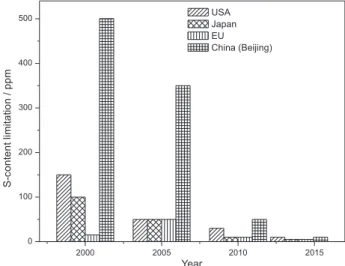
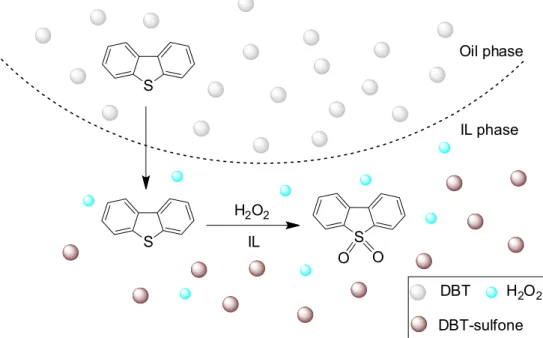
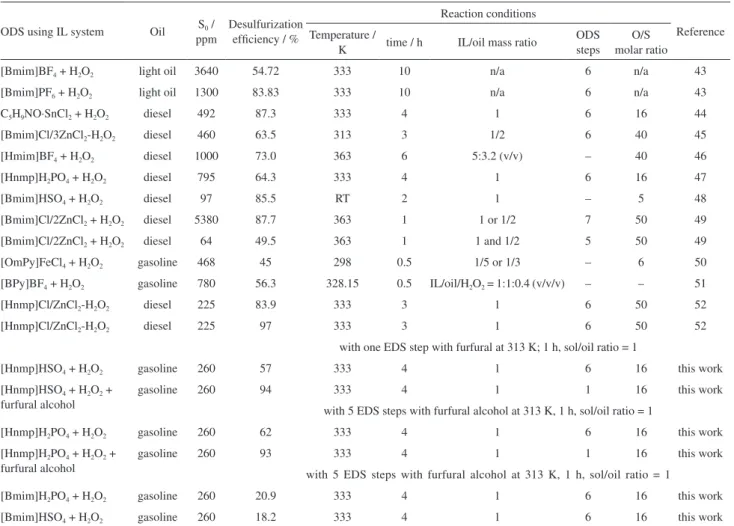
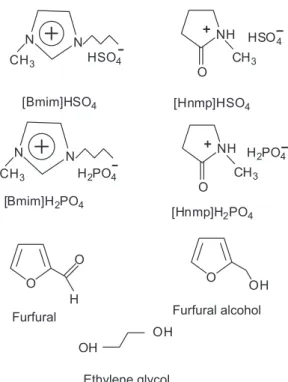
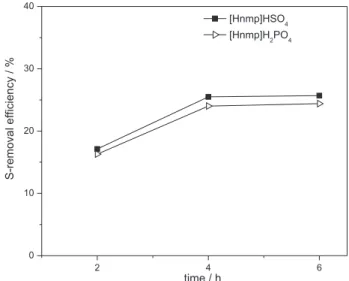
![Figure 6. Influence of temperature for ODS S-removal efficiency of [Hnmp]H 2 PO 4 and [Hnmp]HSO 4 (after one-step ODS, 4 h, 260 ppm of initial S-content, 16 of molar ratio of O/S, 1:1 of mass ratio of IL/oil).](https://thumb-eu.123doks.com/thumbv2/123dok_br/18999990.463432/6.892.477.824.116.702/figure-influence-temperature-removal-efficiency-hnmp-initial-content.webp)
